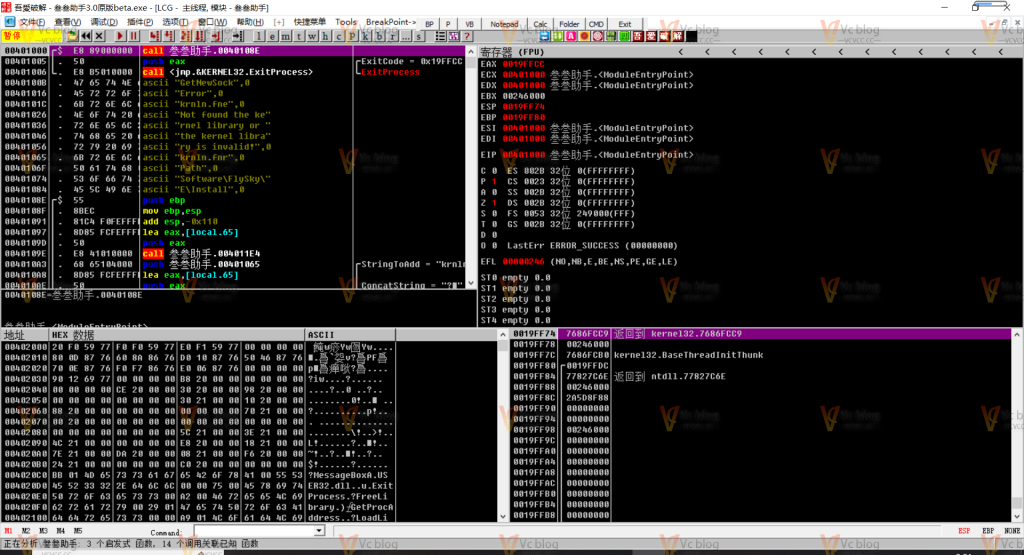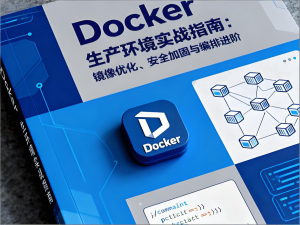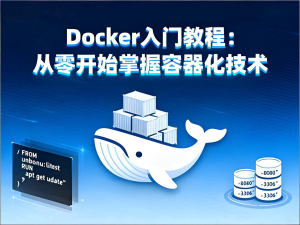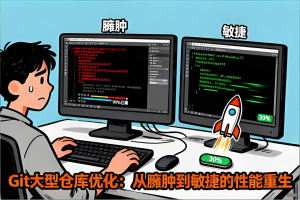Git作为现代软件开发的基石,其深度掌握对团队协作效率至关重要。本文从Git底层对象模型出发,系统解析高级操作技巧、性能优化策略和企业级工作流设计,为开发团队提供完整的版本管理解决方案和复杂场景应对方案。
![图片[1]-Git高级技巧与团队协作实战:从底层原理到企业级工作流深度解析](https://blogimg.vcvcc.cc/2025/11/20251115124033237-1024x768.png?imageView2/0/format/webp/q/75)
Git高级技巧与团队协作实战:从底层原理到企业级工作流深度解析
摘要
Git作为现代软件开发的基石,其深度掌握对团队协作效率至关重要。本文从Git底层对象模型出发,系统解析高级操作技巧、性能优化策略和企业级工作流设计,为开发团队提供完整的版本管理解决方案和复杂场景应对方案。
一、Git底层原理深度剖析
1. Git对象模型解析
Git的核心是基于内容寻址的文件系统,理解其对象模型是掌握高级技巧的基础。
Git四大对象类型:
Blob对象:存储文件内容
# 查看blob对象内容
echo "Hello Git" | git hash-object -w --stdin
git cat-file -p <blob-hash>Tree对象:代表目录结构
# 查看tree对象
git ls-tree <tree-hash>
git cat-file -p <tree-hash>Commit对象:提交信息与关联
# 解析commit对象
git cat-file -p <commit-hash>
git show --pretty=raw <commit-hash>Tag对象: annotated tag存储
# 创建带注释的标签
git tag -a v1.0 -m "Release version 1.0"
git cat-file -p v1.02. 引用机制与HEAD原理
Git引用是指向commit的指针,理解引用机制对分支管理至关重要。
# 查看引用文件
cat .git/HEAD
cat .git/refs/heads/main
# 引用日志排查问题
git reflog show HEAD
git reflog show <branch-name>
# 引用更新原理
git update-ref refs/heads/feature-branch <commit-hash>二、高级操作与性能优化
1. 高效分支管理策略
分支命名规范
feature/ # 功能开发分支
bugfix/ # 缺陷修复分支
hotfix/ # 紧急修复分支
release/ # 发布分支分支清理与维护
# 批量删除已合并分支
git branch --merged main | grep -v "main" | xargs git branch -d
# 清理远程追踪分支
git fetch --prune
# 批量重命名分支
git branch -m old-name new-name2. 提交历史优化技巧
交互式重写历史
# 合并多个提交
git rebase -i HEAD~5
# 修改提交信息
git commit --amend
# 拆分大提交
git reset HEAD~1
git add -p
git commit -m "Part 1"
git commit -m "Part 2"提交签名验证
# 配置GPG签名
git config --global user.signingkey <gpg-key-id>
git config --global commit.gpgsign true
# 签名提交
git commit -S -m "Signed commit"
# 验证签名
git log --show-signature3. 大仓库性能优化
仓库瘦身策略
# 识别大文件
git rev-list --objects --all | \
git cat-file --batch-check='%(objecttype) %(objectname) %(objectsize) %(rest)' | \
awk '/^blob/ {print substr($0,6)}' | \
sort --numeric-sort --key=2 | \
tail -10
# 清理历史大文件
git filter-repo --strip-blobs-bigger-than 10M
# 重写历史移除文件
git filter-branch --tree-filter 'rm -f large-file.zip' HEAD部分克隆与稀疏检出
# 部分克隆
git clone --filter=blob:none <repository-url>
git clone --depth 1 <repository-url>
# 稀疏检出
git sparse-checkout init --cone
git sparse-checkout set src/docs三、团队协作工作流设计
1. 企业级Git工作流
Git Flow工作流
# 功能开发流程
git checkout -b feature/user-authentication develop
git commit -m "Implement user auth"
git checkout develop
git merge --no-ff feature/user-authentication
# 发布流程
git checkout -b release/1.2.0 develop
git commit -m "Bump version to 1.2.0"
git checkout main
git merge --no-ff release/1.2.0
git tag -a v1.2.0
# 紧急修复流程
git checkout -b hotfix/critical-bug main
git commit -m "Fix critical bug"
git checkout main
git merge --no-ff hotfix/critical-bug
git checkout develop
git merge --no-ff hotfix/critical-bug提交信息规范
<type>(<scope>): <subject>
<body>
<footer>
类型说明:
feat: 新功能
fix: 缺陷修复
docs: 文档更新
style: 代码格式调整
refactor: 重构
test: 测试相关
chore: 构建过程或辅助工具变动2. 代码审查优化
预提交钩子配置
<strong>#!/bin/bash</strong>
# .git/hooks/pre-commit
# 检查提交信息格式
commit_msg=$(cat $1)
if ! echo "$commit_msg" | grep -qE "^(feat|fix|docs|style|refactor|test|chore)\(.*\): .{1,}"; then
echo "错误: 提交信息格式不正确"
echo "格式: <type>(<scope>): <subject>"
exit 1
fi
# 运行测试
npm test
if [ $? -ne 0 ]; then
echo "测试失败,请修复后再提交"
exit 1
fiPull Request模板
<strong>## 变更描述</strong>
[简要描述本次PR的变更内容]
<strong>## 变更类型</strong>
- [ ] 新功能
- [ ] 缺陷修复
- [ ] 文档更新
- [ ] 代码重构
- [ ] 其他
<strong>## 测试验证</strong>
- [ ] 单元测试通过
- [ ] 集成测试通过
- [ ] 手动测试验证
<strong>## 相关Issue</strong>
Closes #<issue-number>四、复杂场景解决方案
1. 合并冲突高级处理
复杂冲突解决
# 使用合并工具
git mergetool
# 中止合并
git merge --abort
# 手动解决后标记解决
git add resolved-file.js
git commit
# 使用ours/theirs策略
git checkout --ours conflicted-file.js
git checkout --theirs conflicted-file.js重基冲突处理
# 交互式重基中的冲突处理
git rebase -i main
# 冲突时处理
git add resolved-file.js
git rebase --continue
# 跳过当前提交
git rebase --skip
# 中止重基
git rebase --abort2. 子模块高级管理
子模块工作流
# 添加子模块
git submodule add <repository-url> path/to/submodule
# 更新子模块
git submodule update --init --recursive
# 子模块批量操作
git submodule foreach 'git checkout main && git pull'
# 子模块状态检查
git submodule status子模块进阶配置
# .gitmodules配置示例
[submodule "external/library"]
path = libs/external-library
url = https://github.com/user/repo.git
branch = main
update = rebase五、问题排查与恢复
1. 数据恢复策略
误删恢复
# 恢复误删分支
git reflog
git checkout -b recovered-branch <commit-hash>
# 恢复误删文件
git checkout HEAD -- deleted-file.js
# 恢复误删提交
git cherry-pick <lost-commit-hash>仓库修复
# 文件系统检查
git fsck --full
# 恢复损坏对象
git cat-file -t <object-hash>
git hash-object -w <file-path>
# 重新打包优化
git repack -a -d --depth=50 --window=100
git gc --aggressive2. 性能问题诊断
性能分析命令
# 仓库大小分析
git count-objects -vH
# 提交历史分析
git log --oneline --graph --decorate
# 文件变更统计
git diff --stat <commit<strong>1</strong>> <commit<strong>2</strong>>
# 性能基准测试
git perf网络优化配置
# 配置网络参数
git config --global http.postBuffer 524288000
git config --global core.compression 9
# 使用SSH压缩
git config --global core.sshCommand "ssh -C"
# 并行获取
git config --global fetch.parallel 10六、自动化与集成
1. Git钩子自动化
服务端钩子
<strong>#!/bin/bash</strong>
# .git/hooks/pre-receive
# 分支保护
while read oldrev newrev refname; do
if [[ $refname = "refs/heads/main" ]]; then
if [[ $oldrev != "0000000000000000000000000000000000000000" ]]; then
echo "错误: 不允许直接推送到main分支"
exit 1
fi
fi
done客户端钩子优化
<strong>#!/bin/bash</strong>
# .git/hooks/pre-push
# 推送前检查
current_branch=$(git symbolic-ref --short HEAD)
if [[ "$current_branch" == "main" ]]; then
echo "警告: 正在推送main分支"
read -p "确认继续? (y/n) " -n 1 -r
if [[ ! $REPLY =~ ^[Yy]$ ]]; then
exit 1
fi
fi
# 运行测试套件
npm run test:ci2. CI/CD集成
GitLab CI配置
stages:
- test
- build
- deploy
before_script:
- git fetch --unshallow
test:
stage: test
script:
- git diff --name-only $CI_COMMIT_BEFORE_SHA $CI_COMMIT_SHA
- npm test
build:
stage: build
only:
- main
- develop
script:
- npm run build七、安全与权限管理
1. 仓库安全配置
签名验证
# 强制签名提交
git config --global commit.gpgsign true
# 验证历史提交
git log --show-signature
# 配置可信签名者
git config --global user.signingkey <key-id>访问控制
# 仓库权限检查
git config --global core.sharedRepository group
# 文件权限维护
git update-index --chmod=+x script.sh总结与最佳实践
核心原则总结
- 理解底层原理:掌握Git对象模型是高级操作的基础
- 规范工作流程:建立统一的团队协作规范
- 预防优于修复:通过钩子和检查避免常见问题
- 持续性能优化:定期维护仓库健康状态
企业级实践建议
- 建立代码审查和自动化检查流程
- 设计适合团队的分支策略和工作流
- 实施定期的仓库维护和清理
- 配置完善的备份和恢复机制
- 建立安全审计和权限管理体系
通过系统性地应用这些高级技巧和最佳实践,团队可以显著提升版本控制效率,降低协作成本,构建更加稳定可靠的软件开发流程。
© 版权声明
THE END
















暂无评论内容